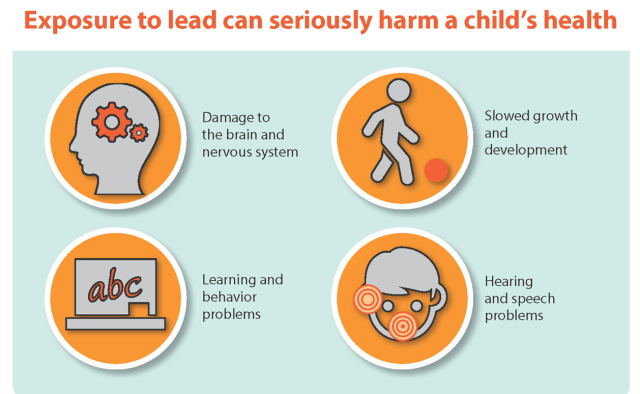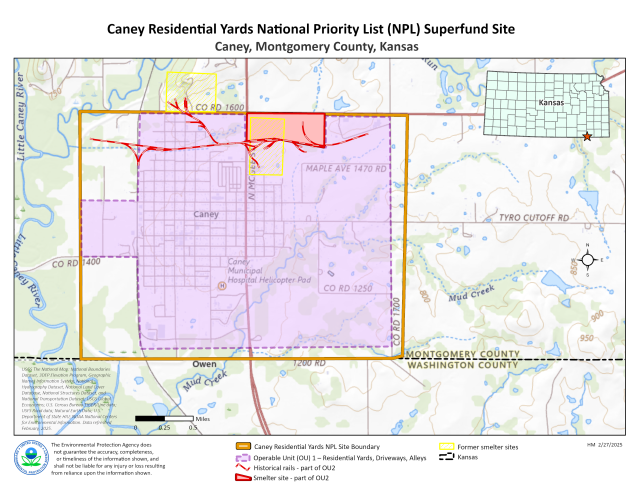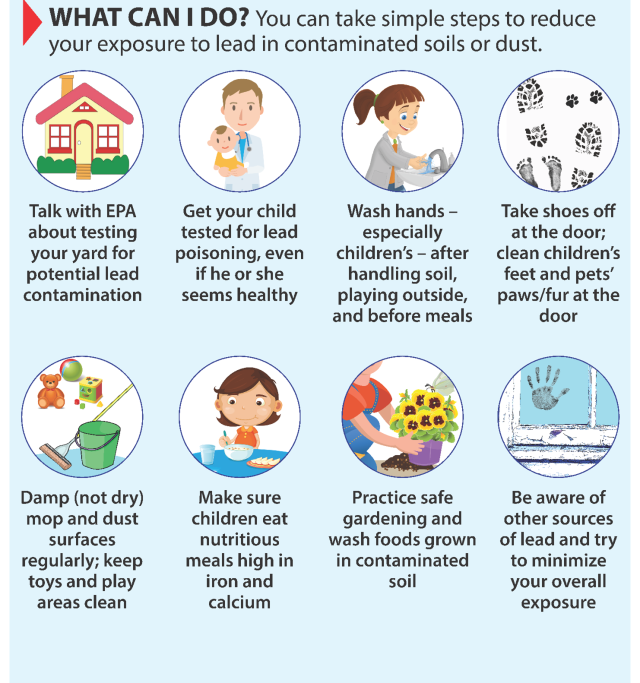Caney Residential Yards National Priorities List (NPL) Superfund Site, Caney, Montgomery County, Kansas – Fact Sheet, January 2023
Free Lead Testing and Cleanup Opportunity
Additional Properties Now Eligible for Cleanup
Overview of EPA’s Cleanup Decision

The U.S. Environmental Protection Agency (EPA) Region 7 recently announced an Interim Record of Decision (IROD) to clean up lead contamination in residential yards and child high-use areas at the Caney Residential Yards National Priorities List (NPL) Superfund Site in Caney, Kansas.
Lead is the main contaminant of concern at this site. Lead is a toxic metal that is harmful if inhaled or swallowed. It affects multiple body systems and is particularly harmful to children under 7 years old, as well as pregnant women and nursing mothers.
EPA chose “Excavation with Off-Site Disposal” as the Selected Remedy (cleanup decision), Alternative 3. This is an interim (provisional) decision based on the best available science to address childhood lead poisoning and protect families from lead hazards. Determination of a final remedy will be reviewed during implementation of this interim remedy.
What Does This Mean?
EPA will remediate (clean up) lead contamination at residential properties and/or other child high-use areas that meet or exceed EPA’s new cleanup level of 200 parts per million (ppm) of lead in soil. Previously ineligible areas with lead contamination at or above 200 ppm will now be eligible for cleanup (remediation).
Lead Testing Results |
Eligibility |
|---|---|
| Areas (parts/parcels) of residential yards and child high-use areas at or above 200 ppm of lead in soil (site-specific cleanup level) | Eligible for EPA cleanup |
| Areas (parts/parcels) of residential yards and child high-use areas below 200 ppm of lead in soil | Not eligible for cleanup |
Why Cleanup Areas Exceeding 200 ppm Lead in Soil?
Updated calculations using Version 2 of the Integrated Exposure Uptake Biokinetic Model informed this cleanup level; this is explained in EPA Region 7’s current Interim Lead Policy. The decision was also based on community and partner agency input, a public comment period and meeting, and consideration of other factors.
Free Lead Testing and Cleanup
If your property has not been sampled (tested) for potential lead contamination, please contact EPA (see below). Soil lead testing and remediation (cleanup) are performed at no cost to property owners! If your residential property qualifies for cleanup, EPA will clean it up for FREE. Just sign EPA’s access agreement (permission form) if it is included with your sampling results letter. Signing and returning the access agreement allows the EPA contractor to start cleaning up the affected areas of the yard. Contact EPA today!
- Call Brian Madeira at 816-319-8940 or toll-free at 1-800-223-0425; or
- Contact by email at madeira.brian@epa.gov
Annual Blood Lead TestingIt is important that children under 7 years old have their blood lead level tested annually, because children suffering from lead poisoning do not always look or act sick. The only way to know if your child has elevated levels of lead in their blood is to have their blood tested. Talk to your pediatrician, general physician, or local health department about testing your child. For more information, contact: Montgomery County Health Department, 604 S. Union, Coffeyville, KS 67337 (phone: 620 251-42100); or the Agency for Toxic Substances and Disease Registry, Cory Kokko, Regional Representative (phone: 913-217-5981, email: ckokko@cdc.gov). For more information about how to protect your family from lead hazards, visit EPA's Lead page or Fact Sheet. |

About Lead and Public Health
Lead is classified by EPA as a probable human carcinogen and is a cumulative toxicant that affects multiple body systems.
Lead is dangerous to children because their growing bodies absorb more lead than adults do, and their brains and nervous systems are more sensitive to the damaging effects of lead.
Lead exposure can cause a range of adverse health effects, including behavioral disorders, learning disabilities, and seizures, putting young children at the greatest risk because their brains and nervous systems are still developing.
About Excavation with Off-Site Disposal
EPA considered four different alternatives and decided on: Alternative 3: Excavation with Off-Site Disposal, which represents the same activities performed during previous removal actions at the site with parcels/cell greater than 400 parts per million (ppm) of lead.

The IROD includes a summary of the cleanup decision and the alternatives evaluated for use at the site, based on the Remedial Investigation (RI) data from surface soil investigations conducted at the site between 2016 and 2020. The IROD includes a Responsiveness Summary to address any substantive public comments received.
Site Background
Historically, two smelters were located and operated in Caney, Kansas, from approximately 1904 to 1922.
The American Zinc, Lead and Smelting (AZLS) Company smelter operated at the site of the current high school building. The Owens Zinc Company (OZC) operated in Caney between 1915 and 1931.
Caney also had two separate brick manufacturing plants during the same time frame as the smelter operations. Smelter deposition and manual relocation of waste resulted in contaminated properties within the city. The Caney Residential Yards Site was listed on the NPL in 2020.
To date, EPA has tested (sampled) 1,041 residential properties and 344 were remediated due to lead soil contamination greater than 400 ppm; approximately 32 residential properties have not been sampled for lead contamination.
Information Repository and Administrative Record AvailableSite project information is available to the public at web repositories. To view the final IROD, Administrative Record File, Proposed Plan, Remedial Investigation, Baseline Human Health Risk Assessment, Ecological Risk Assessment, and other cleanup documents for the site, please visit EPA’s Site Profile Page (see Site Documents & Data). If you do not have internet access, documents are also available during normal business hours at the Caney Public Library, 211 W. 5th Ave., Caney, KS 67333 (620-879-5341); and the EPA Region 7 Records Center, 11201 Renner Blvd., Lenexa, KS 66219 (1-800-223-0425). |

Additional Information
For more information about lead, visit:
- EPA's Lead page
- EPA's Learn About Lead page
- EPA's Lead at Superfund Sites page
- EPA's Fight Lead Poisoning With a Healthy Diet page
- EPA’s Protect Your Family From Lead in Your Home
- CDC’s Lead page
- ATSDR ToxFAQs™
EPA Contact Information
EPA encourages community members to report any site concerns. Questions, comments, or requests for site information can be submitted to EPA:
Elizabeth Kramer
Community Involvement Coordinator
U.S. EPA Region 7 (ORA/OPA)
11201 Renner Boulevard
Lenexa, KS 66219
Phone: 913-551-7186
Toll-free: 1-800-223-0425
Email: kramer.elizabeth@epa.gov
Brian Madeira
Remedial Project Manager
U.S. EPA Region 7 (SEMD/LMSE/MSRS)
11201 Renner Boulevard
Lenexa, KS 66219
Phone: 816-319-8940
Toll-free: 1-800-223-0425
Email: madeira.brian@epa.gov
